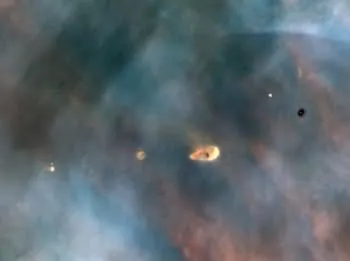
Looking like little islands, these flat discs of cold dust and gas are left over from the formation of a new star in the Orion nebula. Although part of this material will be lost over time, some will eventually clump together in pebble-sized grains before potentially building up to form a baby planet. As such, they are known as protoplanetary discs, or ‘proplyds’.
By learning about proplyds, astronomers hope to find out more about the formation of Earth and the other planets. “This what our Solar System looked like in its infancy,” says Prof C Robert O’Dell, who made this image.
Ground-based telescopes had previously detected the objects, which were initially believed to be stars. The idea that they were discs of material surrounding the star goes back to the 1700s, but confirmation didn’t come until the late 1980s when astronomers managed to detect the disc through observations of its molecules.
The Hubble Space Telescope provided the breakthrough – directly imaging numerous proplyds for the first time within the Orion nebula.
Discover more about the Hubble Space Telescope:
- 10 of Hubble’s greatest discoveries
- Beautiful Hubble Space Telescope images you probably haven’t seen before
- 10 future space missions to look forward to
- Who really discovered Hubble’s Law?
From BBC Sky at Night Magazine:
- Hubble at 30: three decades of the famous space telescope
- 'How we serviced Hubble': Mike Massimino reveals all
- How Hubble’s successor the James Webb Space Telescope will observe the Universe
- Astronaut Kathy Sullivan on launching the famous space telescope
- What was wrong with Hubble’s mirror, and how was it fixed?
- Radio Astronomy Podcast: 30 years of the incredible space telescope
- How did the space telescope come about?
- What Hubble's launch meant to me, as an amateur astronomer
- How Hubble changed our view of the Universe
- Why did astronauts service the Hubble Space Telescope?
- How the Hubble Space Telescope is used to study exoplanets
- A history of the Hubble Space Telescope
